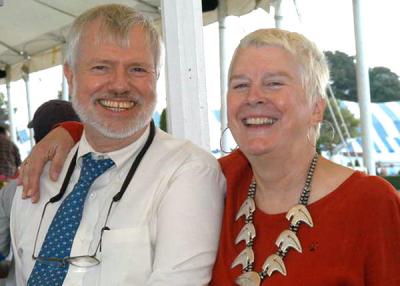Recalling Disasters Past At the Hampton Classic

Forewarned regarding Hurricane Irene, Shanette Barth Cohen, the Hampton Classic’s executive director, on Friday announced the cancellation of Opening Day, which was to have been Sunday, and resolved to restart the ordinarily weeklong hunter-jumper show on Wednesday, Aug. 31.
The three-day postponement was apparently a first for this prestigious show, which in its modern era — first at the Topping Riding Club in Sagaponack, then at Dune Alpin Farm in East Hampton, and, from 1982 at the 60-acre showgrounds on Snake Hollow Road in Bridgehampton — has been no stranger to the vagaries of nature.
Jean Lindgren, who, with her husband, Tony Hitchcock, oversaw the Classic for almost 30 years, before Barth Cohen took over, said during a telephone conversation Saturday that she remembered all sorts of Classic disasters, “but, somehow, the show,” she said, “always went on,” as apparently its doing this year too.
According to the Classic’s Web site’s history section, “the year the show was expanded from a one-day one to a rated five-day show and moved from the Topping Riding Club to Dune Alpin, a hurricane hit just before it was to open, taking down all the tents. They were re-erected and the show started a day and a half late.”
“I remember that hurricane — it arrived almost unannounced,” said Lindgren. “Most people had vans for the horses, so they put them in them and got out. Axes were taken to the tents. They had the show anyway, but without the tents. Tony and I were the caterers that year. We were the only food on the grounds and the power was out. We went to King Kullen, which was where T.J. Maxx is now. They opened the store for us and we went through the dark aisles with flashlights as they added things up. It was all very exciting.”
And the tornado? “I don’t remember the year, but there was one. They were putting the tents up. They hadn’t gotten the stalls in. But the tents all went up in the air. Bud Topping, who was the groundskeeper, ducked under his tractor when he saw grandstand seating fly by. His assistant . . . just stood there, oblivious. I don’t think he was very observant. We had an office on Main Street in Bridgehampton. Everything was fine there, and when David Wright, who was the show’s second manager, phoned and told us what was happening, we went, ‘Ha-ha-ha.’ He had a reputation as a joker. But when we went over, it was as he’d said, everything was gone! Completely destroyed. It was a couple of days before the show was to begin, the horses weren’t there yet. Tony was calling people in the party business, asking them if they had any tents lying around in their basements. We took anything we could get and, yes, the show went on.”
“The first year we were in Bridgehampton, I remember seeing Tinka Topping and Agnetta Currey up to their knees in mud, trying to divert the water so it wouldn’t come into the tents. Remember, this had been a potato field. I remember riders helping to push an ambulance off after a rider had fallen. I’d just bought a new car and there was mud over the hood and I remember Bud pulling me out. . . .”
“One year,” Lindgren continued, “we had to cancel the Friday classes, which included the Grand Prix qualifying class, because of the threat of a hurricane or a tropical storm. It was a big deal because of that qualifying class. But people called and said they had parties arranged and couldn’t they come anyway? We said we didn’t mind. The tents were holding.”
Speaking of tents, she said that “they’ll be able to put them back up easily this year — they’ve flattened the stalls and they’ve lashed the tents on top of them.”
Last year, she said, Hurricane Earl, which was moving up the East Coast as the show was under way, had Barth Cohen and her staff wondering whether they’d have to close early.
As it turned out, Earl was the hurricane that wasn’t, though the results of some hunter classes were doubled to make sure things went smoothly. There were no cancellations, although the Grand Prix Qualifier was moved ahead a day.
And again, the show went on.
